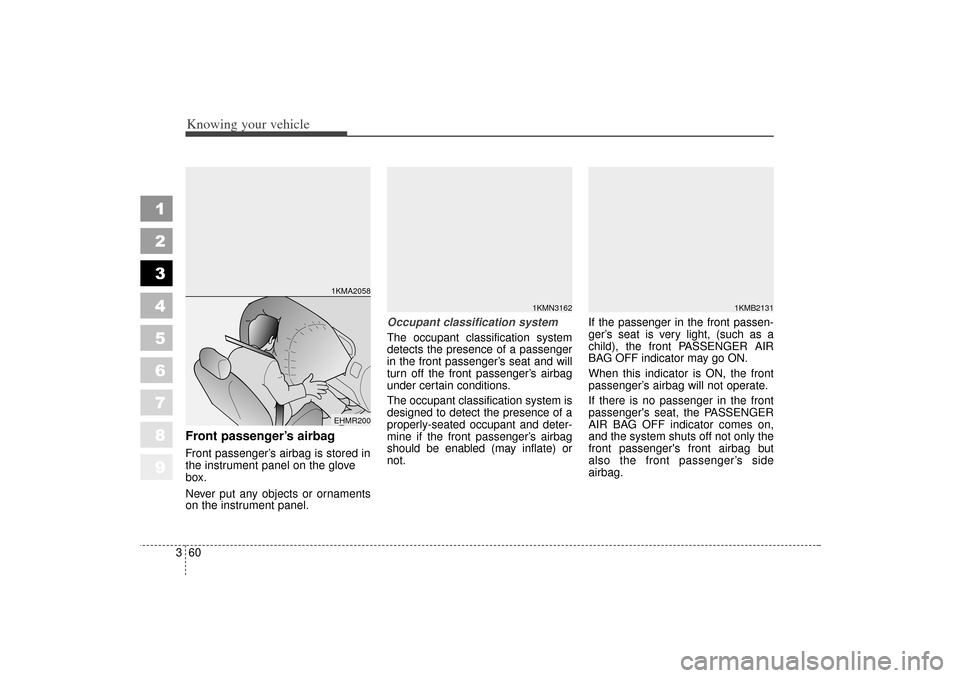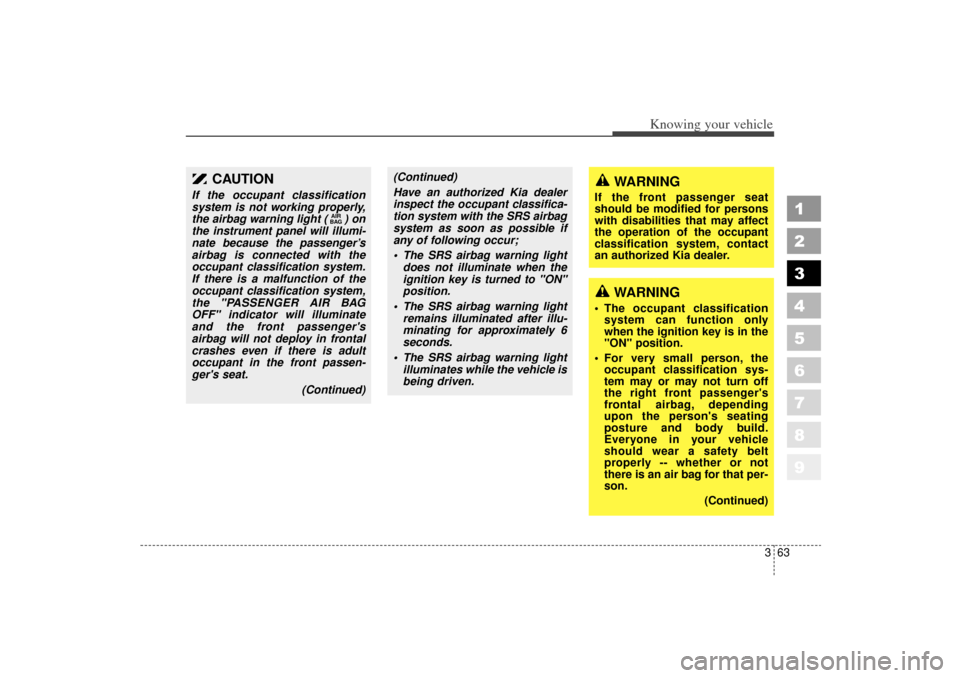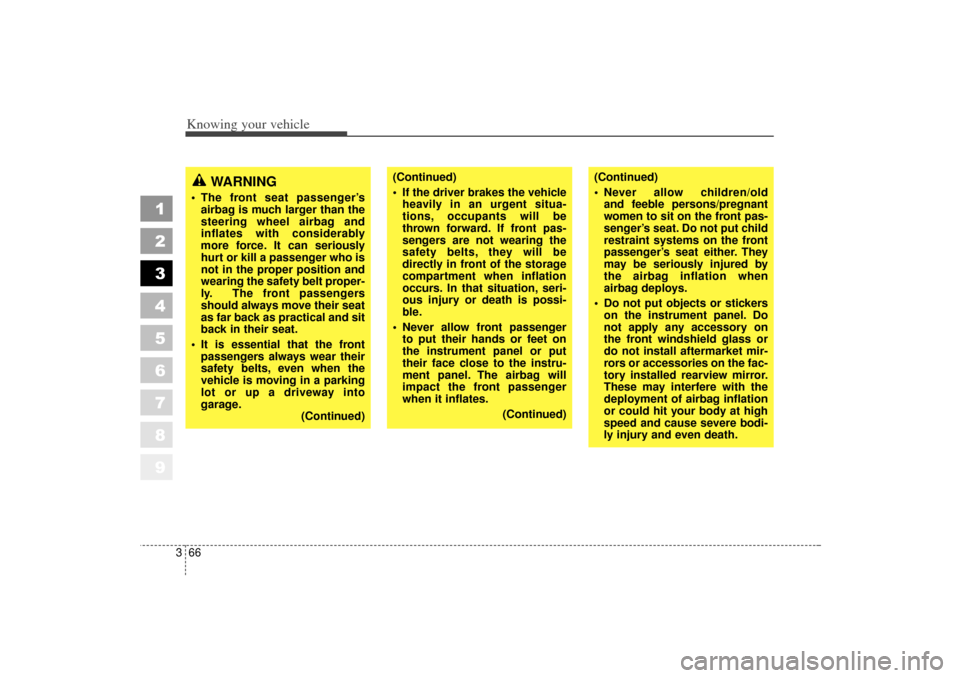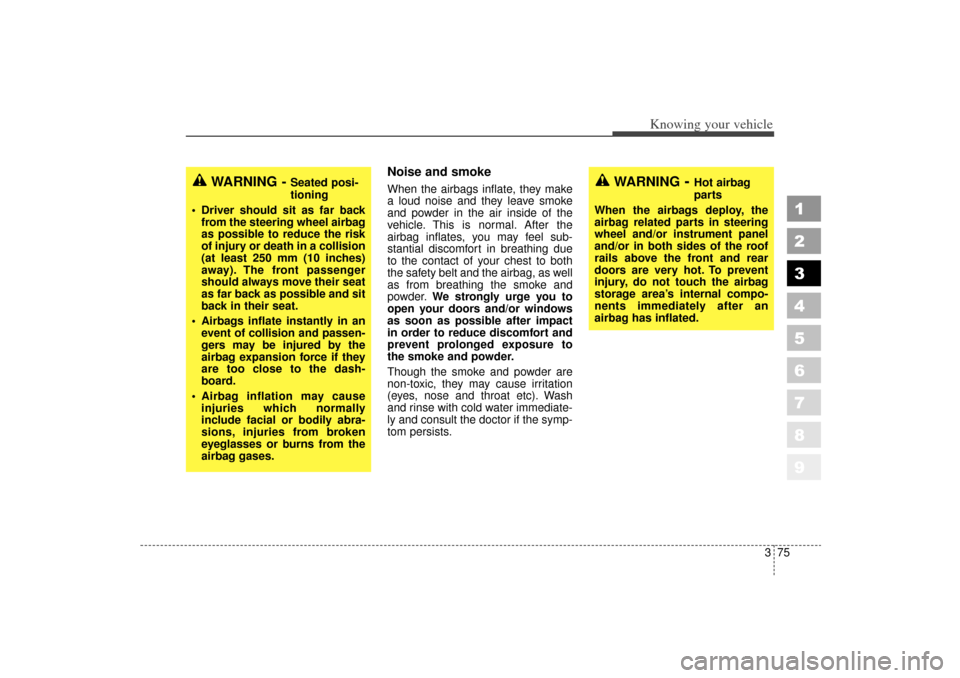Page 7 of 354
1
2
3
4
5
6
7
8
9
Exterior overview / 2-2
Interior overview / 2-4
Instrument panel overview / 2-5
Your vehicle at a glance
KM CAN (ENG) 2.qxd 7/29/05 9:31 AM Page 1
Page 10 of 354
Your vehicle at a glance42
1
2
3
4
5
6
7
8
9
INTERIOR OVERVIEW
1. Door lock/unlock button
2. Power window switches
3. Outside rearview mirror control switch(if equipped)
4. Hood release lever
5. Instrument panel illumination (if equipped)
6. Traction control system (if equipped) / Electronic stability program
(if equipped)
7. 4WD LOCK button (if equipped)
8. Steering wheel tilt
9. Brake pedal
10. Accelerator pedal
11. Seat
12. Parking brake lever
13. Fuel filler lid release lever
1KMB0004/1KMA2019A
KM CAN (ENG) 2.qxd 7/29/05 9:31 AM Page 4
Page 11 of 354
25
1
2
3
4
5
6
7
8
9
Your vehicle at a glance
INSTRUMENT PANEL OVERVIEW
1. Driver’s airbag
2. Light control / Turn signals
3. Instrument cluster
4. Wiper/Washer
5. Ignition switch
6. Steering wheel
7. Digital clock
8. Hazard
9. Audio controls (if equipped)
10. Climate control system (if equipped)
11. Passenger’s airbag
12. Vent controls
13. Glove box
14. Ashtray
15. Cigar lighter
16. Shift lever
17. Auto cruise controls (if equipped)
18. PASSENGER AIR BAG OFF indicator
1KMA0003
KM CAN (ENG) 2.qxd 7/29/05 9:31 AM Page 5
Page 14 of 354

357
1
2
3
4
5
6
7
8
9
Knowing your vehicle
Airbag system components The main components of your SRS
are:
To indicate that your vehicle isequipped with airbags, the corre-
sponding airbag covers are
marked with “SRS AIRBAG”.
- Driver’s airbag (see page 3- 59)
- Passenger’s airbag (see page 3- 60)
- Side airbag (if equipped, see page 3- 67)
- Curtain airbag (if equipped, see page 3- 67)
A diagnostic system that continual- ly monitors the system operation.
Airbag warning light to warn you of a possible problem with the sys-
tem.
Emergency power backup in case your car’s electrical system is dis-
connected in a crash. The SRS uses a collection of sen-
sors to gather information about the
driver’s and front passenger’s seat
position, the driver’s and front pas-
senger’s safety belt usage and
impact severity.
The driver's and front passenger's
seat position sensors, which are
installed on the seat track let the
airbag control module know where
the seats are positioned. Similarly,
the safety belt usage sensors meas-
ure if the driver and front passenger’s
safety belts are fastened. These sen-
sors provide the ability to control the
SRS deployment based on how
close the driver’s seat is to the steer-
ing wheel, how close the passen-
ger’s seat is to the instrument panel,
whether or not the safety belts are
fastened, and the severity of the
impact.
(Continued)
If your vehicle has been sub-
jected to flood conditions (e.g.
soaked carpeting/standing
water on the floor of the vehi-
cle, etc.) or if your vehicle has
become flood damaged in any
way, do not attempt to start
the vehicle or put the key in
the ignition. Have the vehicle
towed to an authorized Kia
dealer for inspection and nec-
essary repairs.
Disregarding this precaution
may cause an unexpected
airbag deployment, which
could result in serious per-
sonal injury or death.
KM CAN (ENG) 3 (55~)new.qxd 7/29/05 9:37 AM Page 57
Page 17 of 354

Knowing your vehicle60
3
1
2
3
4
5
6
7
8
9
Front passenger’s airbagFront passenger’s airbag is stored in
the instrument panel on the glove
box.
Never put any objects or ornaments
on the instrument panel. Occupant classification system
The occupant classification system
detects the presence of a passenger
in the front passenger’s seat and will
turn off the front passenger’s airbag
under certain conditions.
The occupant classification system is
designed to detect the presence of a
properly-seated occupant and deter-
mine if the front passenger’s airbag
should be enabled (may inflate) or
not.
If the passenger in the front passen-
ger’s seat is very light, (such as a
child), the front PASSENGER AIR
BAG OFF indicator may go ON.
When this indicator is ON, the front
passenger’s airbag will not operate.
If there is no passenger in the front
passenger's seat, the PASSENGER
AIR BAG OFF indicator comes on,
and the system shuts off not only the
front passenger's front airbag but
also the front passenger’s side
airbag.
1KMB2131
1KMN3162
1KMA2058EHMR200
KM CAN (ENG) 3 (55~)new.qxd 7/29/05 9:37 AM Page 60
Page 20 of 354

363
1
2
3
4
5
6
7
8
9
Knowing your vehicle
CAUTION
If the occupant classification
system is not working properly,
the airbag warning light ( ) on
the instrument panel will illumi-
nate because the passenger’s
airbag is connected with the
occupant classification system.
If there is a malfunction of the
occupant classification system,
the "PASSENGER AIR BAG
OFF" indicator will illuminate
and the front passenger's
airbag will not deploy in frontal
crashes even if there is adult
occupant in the front passen-
ger's seat.(Continued)
AIR
BAG
(Continued)
Have an authorized Kia dealer
inspect the occupant classifica-
tion system with the SRS airbag
system as soon as possible if
any of following occur;
The SRS airbag warning light
does not illuminate when the
ignition key is turned to "ON"
position.
The SRS airbag warning light remains illuminated after illu-
minating for approximately 6
seconds.
The SRS airbag warning light illuminates while the vehicle is
being driven.
WARNING
The occupant classificationsystem can function only
when the ignition key is in the
"ON" position.
For very small person, the occupant classification sys-
tem may or may not turn off
the right front passenger's
frontal airbag, depending
upon the person's seating
posture and body build.
Everyone in your vehicle
should wear a safety belt
properly -- whether or not
there is an air bag for that per-
son.
(Continued)
WARNING
If the front passenger seat
should be modified for persons
with disabilities that may affect
the operation of the occupant
classification system, contact
an authorized Kia dealer.
KM CAN (ENG) 3 (55~)new.qxd 7/29/05 9:37 AM Page 63
Page 23 of 354

Knowing your vehicle66
3
1
2
3
4
5
6
7
8
9
(Continued)
If the driver brakes the vehicle
heavily in an urgent situa-
tions, occupants will be
thrown forward. If front pas-
sengers are not wearing the
safety belts, they will be
directly in front of the storage
compartment when inflation
occurs. In that situation, seri-
ous injury or death is possi-
ble.
Never allow front passenger to put their hands or feet on
the instrument panel or put
their face close to the instru-
ment panel. The airbag will
impact the front passenger
when it inflates.
(Continued)
(Continued)
Never allow children/old and feeble persons/pregnant
women to sit on the front pas-
senger’s seat. Do not put child
restraint systems on the front
passenger’s seat either. They
may be seriously injured by
the airbag inflation when
airbag deploys.
Do not put objects or stickers on the instrument panel. Do
not apply any accessory on
the front windshield glass or
do not install aftermarket mir-
rors or accessories on the fac-
tory installed rearview mirror.
These may interfere with the
deployment of airbag inflation
or could hit your body at high
speed and cause severe bodi-
ly injury and even death.
WARNING
The front seat passenger’sairbag is much larger than the
steering wheel airbag and
inflates with considerably
more force. It can seriously
hurt or kill a passenger who is
not in the proper position and
wearing the safety belt proper-
ly. The front passengers
should always move their seat
as far back as practical and sit
back in their seat.
It is essential that the front passengers always wear their
safety belts, even when the
vehicle is moving in a parking
lot or up a driveway into
garage. (Continued)
KM CAN (ENG) 3 (55~)new.qxd 7/29/05 9:37 AM Page 66
Page 32 of 354

375
1
2
3
4
5
6
7
8
9
Knowing your vehicle
Noise and smokeWhen the airbags inflate, they make
a loud noise and they leave smoke
and powder in the air inside of the
vehicle. This is normal. After the
airbag inflates, you may feel sub-
stantial discomfort in breathing due
to the contact of your chest to both
the safety belt and the airbag, as well
as from breathing the smoke and
powder.We strongly urge you to
open your doors and/or windows
as soon as possible after impact
in order to reduce discomfort and
prevent prolonged exposure to
the smoke and powder.
Though the smoke and powder are
non-toxic, they may cause irritation
(eyes, nose and throat etc). Wash
and rinse with cold water immediate-
ly and consult the doctor if the symp-
tom persists.
WARNING -
Seated posi-
tioning
Driver should sit as far back from the steering wheel airbag
as possible to reduce the risk
of injury or death in a collision
(at least 250 mm (10 inches)
away). The front passenger
should always move their seat
as far back as possible and sit
back in their seat.
Airbags inflate instantly in an event of collision and passen-
gers may be injured by the
airbag expansion force if they
are too close to the dash-
board.
Airbag inflation may cause injuries which normally
include facial or bodily abra-
sions, injuries from broken
eyeglasses or burns from the
airbag gases.
WARNING
- Hot airbag
parts
When the airbags deploy, the
airbag related parts in steering
wheel and/or instrument panel
and/or in both sides of the roof
rails above the front and rear
doors are very hot. To prevent
injury, do not touch the airbag
storage area’s internal compo-
nents immediately after an
airbag has inflated.
KM CAN (ENG) 3 (55~)new.qxd 7/29/05 9:37 AM Page 75